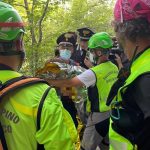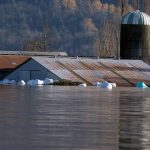The carcass of a rotting donkey fills the air with a foul stench.
Everywhere around us on the banks of the Rio Grande lies human waste, rubbish, nappies, torn immigration paperwork, identity cards from around the world, and clothes – all dumped here by people planning a new life in America and shedding their past.
We’re at one of the many crossing points for illegal migrants attempting to reach the United States; the border is about 50 metres across the river.
The migrants come to the water’s edge when the river flow is at its most gentle. They peer across the water and up and down stream, looking to see if US border patrol officers are active.
If they feel safe, they move.
We stood for hours in one of these crossing clearings, but nobody came. Perhaps not unreasonably we were the reason; so we moved downstream and set up our cameras and equipment in a small clearing surrounded by trees and vegetation and largely inhabited by mosquitoes – vicious mosquitoes.
Within moments we saw the first movement: a man entering the river, striding out in ankle-deep water.
He turned and gestured to someone – it was a woman carrying a very small baby, nervously following behind.
They were carrying a couple of bags, their only worldly possessions.
As she struggled he dropped what he was carrying on an island and went back to help.
Together they moved on, each step taking them to their dreamt-of sanctuary of the United States, every step adding to the weeks, months and even years it had taken them to get here.
Finally they disappeared into the bushes: welcome to America.
Over the next three days we saw a continuous stream of people just like this.
We were tipped off but did not understand, initially, why the crossings took place here between 10am and 2pm. Finally we worked out that the river flow dropped significantly between these hours, making a potentially dangerous river crossing actually quite manageable.
Just getting here is dangerous, however: the migrants have to contend with gangs, the Mexican National Guard and the final obstacle – US border patrols.
The United States border patrols on and off the river are constant. We watched armed officers riding air boats – crafts powered by large propellers above the water – scanning the banks looking for migrants attempting to cross.
They searched with helicopter support hovering overhead.
But in the days we were there we didn’t see them intercept anyone. The migrants waited until the border patrols passed and then they crossed.
This route is popular with Haitians and anyone from countries with recognisably chaotic governments because they can claim asylum.
They know they’ll be detained when they reach America, but they’ll claim asylum nevertheless.
This group, as well as unaccompanied minors from anywhere, are pretty much guaranteed to enter the migrant processing system.
Others are usually just kicked back, but tens of thousands are still trying to get in every single month.
We came across two Haitian families packing their belongings into plastic bags as they prepared to cross the river.
Three children aged two months old, four months, and three years clung onto their parents in silence.
They’ve been in Mexico for three months and the children are used to this unusual life of constant travel and the need for quiet.
The families were hot, sweaty and nervous. A local pastor who had shown them the route to the river said we needed to speak to them quickly as they were in danger from Mexico’s National Guard.
They were happy to talk but felt nervous and desperate to go.
Their story – like those of so many we met – is that life in Haiti is impossible and that the United States is their beacon of hope.
“You choose a path that may be difficult, but you’re looking for a better life, which I think anyone could understand,” one of the men told us.
I asked them what they were hoping for in the US.
“I think life may be easier there,” his friend said, “and we might be able to bring over our family [one day], because things are very hard over there [in Haiti].”
US Customs and Border Protection (CBP) said it detained more than 180,000 migrants in May alone.
And since January, when President Joe Biden came into office, it’s estimated over 50,000 unaccompanied minors have made the crossing.
A few miles away from the Haitian families, at another crossing point on the Rio Grande here in the border town of Acuna, we met Fernando Hernandez.
He’s just 16 years old and had travelled 2,000 miles alone by bus from San Pedro Sula in Honduras to get there.
An older man, also Honduran and looking after him here in Mexico, had taken him to the river to show him where to cross. He told us he wasn’t afraid, but was clearly very nervous.
The river was running high. He explained he couldn’t swim but was going to give it a go.
I asked him why he was taking the risk. “I left because I wanted to try something new and see if I could earn some money to support my family,” he told me.
“I wanted to try to find another home, find a place to live, or find better options.”
He wasn’t worried about being caught on the other side of the border because he was an unaccompanied minor.
In fact, he told us he planned to go straight to US border patrol and hand himself in.
We watched as he waded out into the water, up to his armpits, before losing his nerve and returning to the bank.
The last time I saw him he was sitting on the bank of the Rio Grande staring at the United States, just 50 metres away.
Two thousand miles down but still 50 metres to go – for now.






















